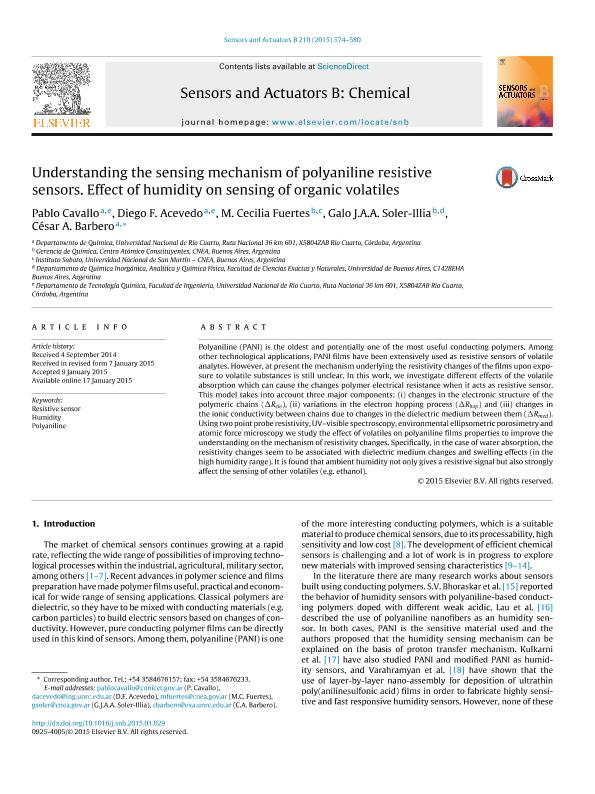Artículo
Understanding the sensing mechanism of polyaniline resistive sensors. Effect of humidity on sensing of organic volatiles
Cavallo, Pablo César ; Acevedo, Diego Fernando
; Acevedo, Diego Fernando ; Fuertes, María Cecilia
; Fuertes, María Cecilia ; Soler Illia, Galo Juan de Avila Arturo
; Soler Illia, Galo Juan de Avila Arturo ; Barbero, César Alfredo
; Barbero, César Alfredo
 ; Acevedo, Diego Fernando
; Acevedo, Diego Fernando ; Fuertes, María Cecilia
; Fuertes, María Cecilia ; Soler Illia, Galo Juan de Avila Arturo
; Soler Illia, Galo Juan de Avila Arturo ; Barbero, César Alfredo
; Barbero, César Alfredo
Fecha de publicación:
01/2015
Editorial:
Elsevier Science Sa
Revista:
Sensors and Actuators B: Chemical
ISSN:
0925-4005
Idioma:
Inglés
Tipo de recurso:
Artículo publicado
Clasificación temática:
Resumen
Polyaniline (PANI) is the oldest and potentially one of the most useful conducting polymers. Among other technological applications, PANI films have been extensively used as resistive sensors of volatile analytes. However, at present the mechanism underlying the resistivity changes of the films upon exposure to volatile substances is still unclear. In this work, we investigate different effects of the volatile absorption which can cause the changes polymer electrical resistance when it acts as resistive sensor. This model takes into account three major components: (i) changes in the electronic structure of the polymeric chains (ΔRele), (ii) variations in the electron hopping process (ΔRhop) and (iii) changes in the ionic conductivity between chains due to changes in the dielectric medium between them (ΔRmed). Using two point probe resistivity, UV-visible spectroscopy, environmental ellipsometric porosimetry and atomic force microscopy we study the effect of volatiles on polyaniline films properties to improve the understanding on the mechanism of resistivity changes. Specifically, in the case of water absorption, the resistivity changes seem to be associated with dielectric medium changes and swelling effects (in the high humidity range). It is found that ambient humidity not only gives a resistive signal but also strongly affect the sensing of other volatiles (e.g. ethanol).
Palabras clave:
Humidity
,
Polyaniline
,
Resistive Sensor
Archivos asociados
Licencia
Identificadores
Colecciones
Articulos(CCT - CORDOBA)
Articulos de CTRO.CIENTIFICO TECNOL.CONICET - CORDOBA
Articulos de CTRO.CIENTIFICO TECNOL.CONICET - CORDOBA
Articulos(SEDE CENTRAL)
Articulos de SEDE CENTRAL
Articulos de SEDE CENTRAL
Citación
Cavallo, Pablo César; Acevedo, Diego Fernando; Fuertes, María Cecilia; Soler Illia, Galo Juan de Avila Arturo; Barbero, César Alfredo; Understanding the sensing mechanism of polyaniline resistive sensors. Effect of humidity on sensing of organic volatiles; Elsevier Science Sa; Sensors and Actuators B: Chemical; 210; 1-2015; 574-580
Compartir
Altmétricas



